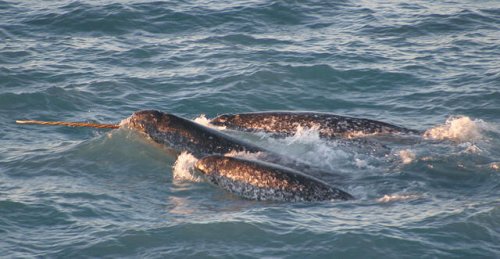Narwhals: The unicorns of the sea

Narwhals are considered to be an endangered species that are difficult to see in the wild. Therefore, these animals are called unicorns because they are difficult to find and they use their horn for hunting.
They seem like mythological creatures, but they are real creatures that live in the ocean. They are called the unicorn of the sea and they are difficult to study. Not all narwhals have the characteristic horn. There is little known about narwhals, however they are exciting animals.
Traits of narwhals
Narwhals are odontocetes cetaceans that are closely related to belugas whales, which means that they are marine mammals with teeth. They are part of the whale family and are known for having a huge horn on the front of their heads, which is actually a tusk.
Male and female narwhals have slightly different bodies. As adults, males weigh an average of 1600 kilos and females can weigh 1,000 kilos. Females are a little smaller than males. Females usually measure around four meters in length while males usually reach up to four and a half meters.
Narwhals change color throughout their lives. When they are born, each Narwhal is gray with their own unique dark spot pattern. These spots disappear once they reach the age of two, but they continue to grow over time. The oldest ones are black because their spots have grown so much that they are completely covered by them.
They differ from other whales because they don’t have dorsal fin, which is trait they have in common with beluga whales. Instead, they have a crest that measures up to one meter in length.
Their most striking feature is the huge tusk in front of their heads. This tusk can reach two meters and weigh more than 10 kilograms. It’s unique in males because females never develop one.
Until recently, it was not known what narwhals use their tusks for. It was believed that they were linked to orientation, and some scientists thought it helped them break thin ice. Recent research shows that narwhals use their tusks to hunt by using very fast movements to stun fish.
Narwhal behavior
Narwhals live in small herds. During the winter, these herds are composed of groups of two to nine individuals. However, in summer, they migrate to the south in enormous herds of hundreds or thousands of narwhals.
Narwhals are particularly noisy cetaceans. Many other species of whales barely make any sound, but narwhals are not only constantly communicating through sound, they make a variety of them.
They routinely produce clicks at different intervals. It’s believed that they use this for echolocation, just like dolphins. However, whistles and other sounds have been detected when they communicate with other narwhals. They can modulate these sounds, which makes specialists think they have a complex language.
When it comes to their diet, these animals get their food from the bottom of the sea. They dive for 30 minutes, and they are known to go down all the way down to 800 meters deep; so, next to sperm whales, they are one of the mammals that can reach the deepest underwater depth.
The narwhal’s habitat
Narwhals are found in a very specific area of the planet. In the winter, they live in the icy waters that surround the North Pole: northern Canada, Greenland and in the northern part of the Arctic Ocean of Russia. In the summer, they make a small migration to the south, and they have been seen in some fjords or in some Canadian inlets.
It’s known that these animals once lived in warmer waters, but as they have evolved, they moved to the coldest waters on the planet. They have a very limited habitat, which is why their population is not very expansive. They have been declared to be an endangered species, even though they hardly have any predators; only the Inuit people hunt them.
The narwhals’ diet
Narwhals are carnivorous animals that only feed on fish and crustaceans. They may hunt among the schools of fish on the surface, but it is common for them to dive to feed on the creatures that inhabit the seabed.
They eat a lot during the beginning of winter and once they have finished migrating north. When there is hardly any ice in the waters where they live, they eat very little or nothing; they can digest their food very slowly which allows them to ingest the prey they have eaten and remain nourished for weeks or months.
Narwhals are another endangered cetacean species, but luckily their protection is guaranteed. Although it is difficult to study them and learn more about them in detail, it seems that their population remains stable. They don’t have much prey and the biggest danger to their survival is pollution.